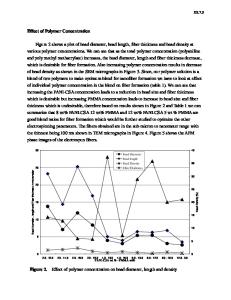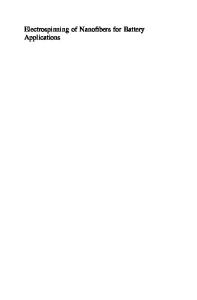Electrospinning of Polymeric Nanofibers: Analysis of Jet Formation
- PDF / 80,154 Bytes
- 6 Pages / 612 x 792 pts (letter) Page_size
- 97 Downloads / 492 Views
Electrospinning of Polymeric Nanofibers: Analysis of Jet Formation Antonio E. Senador Jr.b, Montgomery T. Shawa,b, and Patrick T. Mathera,b,* Polymer Program, Institute of Material Science, and bChemical Engineering, University of Connecticut, Storrs, CT 06269, U.S.A. a
ABSTRACT Producing nanofiber-diameter polymeric fibers presents an attractive and robust approach toward the processing of nanocomposites, with applications ranging from clear optical components to toughened structural materials. In this work, we are examining the electrospinning process for the production of nanometer-diameter polymer fibers, giving particular attention to the following key features: jet-initiation, fiber architecture, and fiber distribution. A wide range of polymer systems and polymer-solvent combinations were studied in order to broaden the applicability of our conclusions to other systems. Specifically, a dimensional analysis was applied to jet-formation data obtained by quantifying the conditions required for the expulsion of fibers from a charged capillary to a grounded collection plate. The relationships between various dimensionless groups were compared with the expressions for the critical voltage that have been proposed for electrospinning of polymer solutions. INTRODUCTION The use of high voltage, alone or in combination with mechanical means, to spin fibers from solutions and melts have been around for at least 75 years now [1,2], but research became rejuvenated in mid-1990’s [3] due to increasing interests in nanomaterials. Prior to this, the electrospinning process has been known to consistently produce fibers in the order of 1 µm, with some excursions into the upper nanometer range. At this early stage, it was already noted that the jet-formation mechanism plays a significant part in the control of the fiber diameter, leading to the establishment of some semi-empirical relationships [1,4]. Apart from finding unique applications for electrospun nanofibers, current research effort is also being focused on improving the process model. An example of this is the modeling of the jet as it extends under the influence of the external field and the repulsion between charge carriers [5,6,7]. However, overly simplistic rules for the initiation of the jet from a Taylor-cone meniscus are still being employed. For example, they often exclude such fluid properties as viscosity and conductivity – properties that vary significantly between polymer melts and solutions, for example. In this work, we quantify the effect of solution properties on the formation of the liquid jet. EXPERIMENTAL DETAILS The polymer-solvent systems used are listed in Table 1, where it can be seen that we have varied the polymer, solvent, and solution concentration systematically to vary such physical properties as electrical conductivity, viscosity, and surface tension over large ranges. While electrospinning from aqueous solutions of poly(ethylene oxide) (PEO) and poly(vinyl alcohol) (PVA) have already been reported [8,9], there is no previous study reporting
Data Loading...











